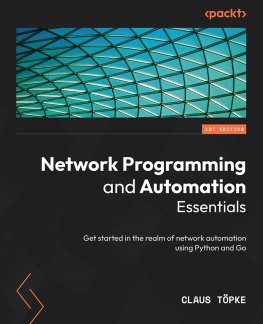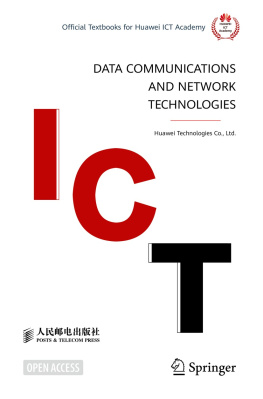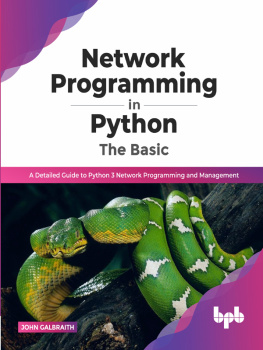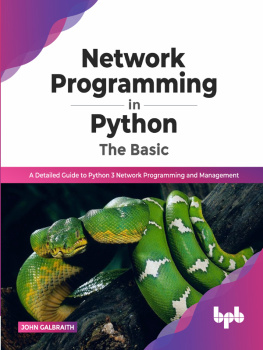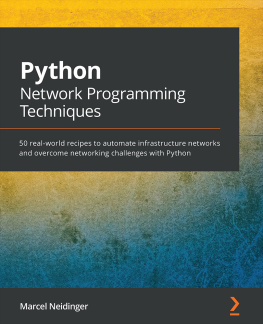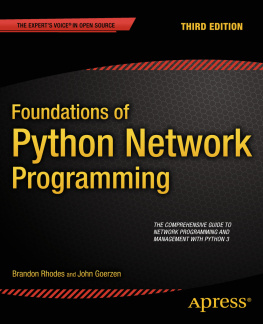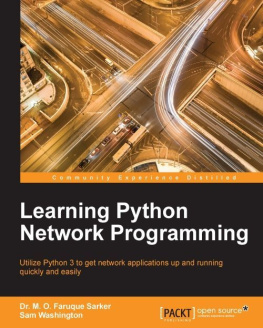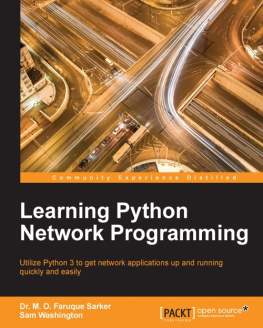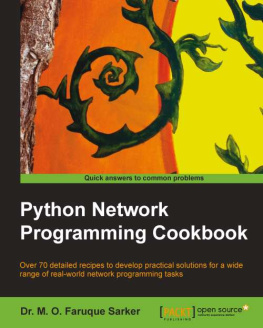Sam Washington - Learning Python Network Programming
Here you can read online Sam Washington - Learning Python Network Programming full text of the book (entire story) in english for free. Download pdf and epub, get meaning, cover and reviews about this ebook. City: Birmingham, year: 2015, publisher: Packt Publishing, genre: Home and family. Description of the work, (preface) as well as reviews are available. Best literature library LitArk.com created for fans of good reading and offers a wide selection of genres:
Romance novel
Science fiction
Adventure
Detective
Science
History
Home and family
Prose
Art
Politics
Computer
Non-fiction
Religion
Business
Children
Humor
Choose a favorite category and find really read worthwhile books. Enjoy immersion in the world of imagination, feel the emotions of the characters or learn something new for yourself, make an fascinating discovery.
- Book:Learning Python Network Programming
- Author:
- Publisher:Packt Publishing
- Genre:
- Year:2015
- City:Birmingham
- Rating:3 / 5
- Favourites:Add to favourites
- Your mark:
Learning Python Network Programming: summary, description and annotation
We offer to read an annotation, description, summary or preface (depends on what the author of the book "Learning Python Network Programming" wrote himself). If you haven't found the necessary information about the book — write in the comments, we will try to find it.
Looking deeperProgramming for TCP/IP networks; Firewalls; Network Address Translation; IPv6; Summary; Chapter 2: HTTP and Working with the Web; Request and response; Requests with urllib; Response objects; Status codes; Handling problems; HTTP headers; Customizing requests; Content compression; Multiple values; Content negotiation; Content types; User agents; Cookies; Cookie handling; Know your cookies; Redirects; URLs; Paths and relative URLs; Query strings; URL encoding; URLs in summary; HTTP methods; The HEAD method; The POST method; Formal inspection; HTTPS; The Requests library.
Handling errors with RequestsSummary; Chapter 3: APIs in Action; Getting started with XML; The XML APIs; The basics of ElementTree; Pretty printing; Element attributes; Converting to text; The Amazon S3 API; Registering with AWS; Authentication; Setting up an AWS user; Regions; S3 buckets and objects; An S3 command-line client; Creating a bucket with the API; Uploading a file; Retrieving an uploaded file through a web browser; Displaying an uploaded file in a web browser; Downloading a file with the API; Parsing XML and handling errors; Parsing XML; Finding elements; Handling errors.
Further enhancementsThe Boto package; Wrapping up with S3; JSON; Encoding and decoding; Using dicts with JSON; Other object types; The Twitter API; A Twitter world clock; Authentication for Twitter; Registering your application for the Twitter API; Authenticating requests; A Twitter client; Polling for Tweets; Processing the tweets; Rate limits; Sending a reply; Final touches; Taking it further; Polling and the Twitter streaming APIs; Alternative oAuth flows; HTML and screen scraping; HTML parsers; Show me the data; Parsing HTML with lxml; Zeroing in; Searching with XPath; XPath conditions.
Pulling it togetherWith great power ... ; Choosing a User Agent; The Robots.txt file; Summary; Chapter 4: Engaging with E-mails; E-mail terminologies; Sending e-mails with SMTP; Composing an e-mail message; Sending an e-mail message; Sending e-mails securely with TLS; Retrieving e-mails by using POP3 with poplib; Retrieving e-mails by using IMAP with imaplib; Sending e-mail attachments; Sending e-mails via the logging module; Summary; Chapter 5: Interacting with Remote Systems; Secure shell - access using Python; Inspecting the SSH packets; Transferring files through SFTP.
Transferring files with FTP.
If youre a Python developer or a system administrator with Python experience and youre looking to take your first steps in network programming, then this book is for you. Basic knowledge of Python is assumed. Read more...
Abstract: Cover; Copyright; Credits; About the Authors; About the Reviewers; www.PacktPub.com; Table of Contents; Preface; Chapter 1: Network Programming and Python; An introduction to TCP/IP networks; IP addresses; Network Interfaces; Assigning IP addresses; IP addresses on the Internet; Packets; Networks; Routing with IP; DNS; The protocol stack or why the Internet is like a cake; Layer 4 - TCP and UDP; Network ports; UDP; TCP; UDP versus TCP; Layer 5 - The application layer; On to Python!; Network programming with Python; Breaking a few eggs; Taking it from the top; Downloading an RFC.
Looking deeperProgramming for TCP/IP networks; Firewalls; Network Address Translation; IPv6; Summary; Chapter 2: HTTP and Working with the Web; Request and response; Requests with urllib; Response objects; Status codes; Handling problems; HTTP headers; Customizing requests; Content compression; Multiple values; Content negotiation; Content types; User agents; Cookies; Cookie handling; Know your cookies; Redirects; URLs; Paths and relative URLs; Query strings; URL encoding; URLs in summary; HTTP methods; The HEAD method; The POST method; Formal inspection; HTTPS; The Requests library.
Handling errors with RequestsSummary; Chapter 3: APIs in Action; Getting started with XML; The XML APIs; The basics of ElementTree; Pretty printing; Element attributes; Converting to text; The Amazon S3 API; Registering with AWS; Authentication; Setting up an AWS user; Regions; S3 buckets and objects; An S3 command-line client; Creating a bucket with the API; Uploading a file; Retrieving an uploaded file through a web browser; Displaying an uploaded file in a web browser; Downloading a file with the API; Parsing XML and handling errors; Parsing XML; Finding elements; Handling errors.
Further enhancementsThe Boto package; Wrapping up with S3; JSON; Encoding and decoding; Using dicts with JSON; Other object types; The Twitter API; A Twitter world clock; Authentication for Twitter; Registering your application for the Twitter API; Authenticating requests; A Twitter client; Polling for Tweets; Processing the tweets; Rate limits; Sending a reply; Final touches; Taking it further; Polling and the Twitter streaming APIs; Alternative oAuth flows; HTML and screen scraping; HTML parsers; Show me the data; Parsing HTML with lxml; Zeroing in; Searching with XPath; XPath conditions.
Pulling it togetherWith great power ... ; Choosing a User Agent; The Robots.txt file; Summary; Chapter 4: Engaging with E-mails; E-mail terminologies; Sending e-mails with SMTP; Composing an e-mail message; Sending an e-mail message; Sending e-mails securely with TLS; Retrieving e-mails by using POP3 with poplib; Retrieving e-mails by using IMAP with imaplib; Sending e-mail attachments; Sending e-mails via the logging module; Summary; Chapter 5: Interacting with Remote Systems; Secure shell - access using Python; Inspecting the SSH packets; Transferring files through SFTP.
Transferring files with FTP.
If youre a Python developer or a system administrator with Python experience and youre looking to take your first steps in network programming, then this book is for you. Basic knowledge of Python is assumed
Sam Washington: author's other books
Who wrote Learning Python Network Programming? Find out the surname, the name of the author of the book and a list of all author's works by series.


